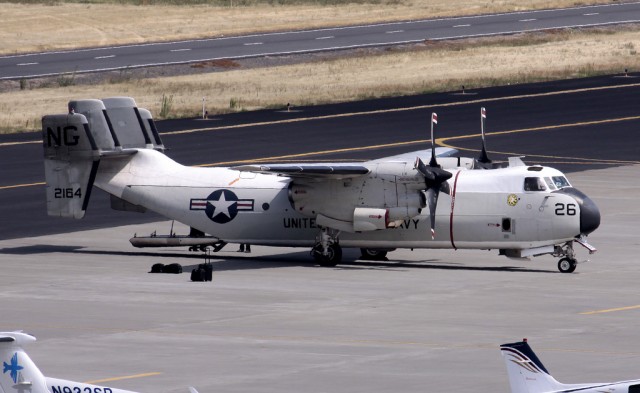
The ubiquitous C-2 that the has become a welcome sight on carrier decks – Photo: Paul Carter
Since 1966, the United States Navy has employed the venerable Grumman C-2 Greyhound as its main source of supplying their fleet of nuclear-powered aircraft carriers with a vital connection to the outside world. Known as the CODs (for Carrier Onboard Delivery), these aircraft transport personnel, spare parts, mail, and other necessities to the carriers from land.
The C-2, based on the Grumman E-2 Hawkeye AWACS platform, can carry up to 26 passengers or 10,000 pounds of cargo to and from an aircraft carrier. The mission of the C-2 has been considered one of the most important in the operations of an aircraft carrier. With the first of 17 C-2s delivered in 1966, and the last in 1968, by the early 80’s, the fleet was beginning to show its age and limitations.
So, what does the C-2 have to do with airliners? In the early 1980’s, the US Navy put out a request for a new COD aircraft through the MMVX program. Various manufacturers tendered proposals, including Grumman, with an improved version of the C-2. Lockheed offered a new, turbofan design derived from the S-3 Viking, and a few unusual proposals.
Fokker Aircraft, of the Netherlands, proposed a derivative of their successful F28 regional airliner, called the F28 Mk.5000. McDonnell Douglas proposed a navalized version of the venerable DC-9-10 airliner, and lastly, it appears as if Boeing proposed a carrier modification of the 737-200. While it might seem odd operating an aircraft the size of an airliner off of the small flight deck of an aircraft carrier, the concept was proven as possible nearly 20 years before the start of the MMVX program.
In November 1963, the Navy conducted tests to see if the idea of a ’œSuper COD’ was possible. These dramatic tests saw a crew, led by Lt. James Flatley, land a KC-130 on the deck of the USS Forrestal 21 times with no tailhook, and take off with no catapult assistance. These tests, while a success, proved that the C-130 was too large of an aircraft to routinely operate off of a carrier, and the Navy in the end procured the C-2.
For this story, I want to take a closer look at the proposed airliners which were made to handle carrier operations.
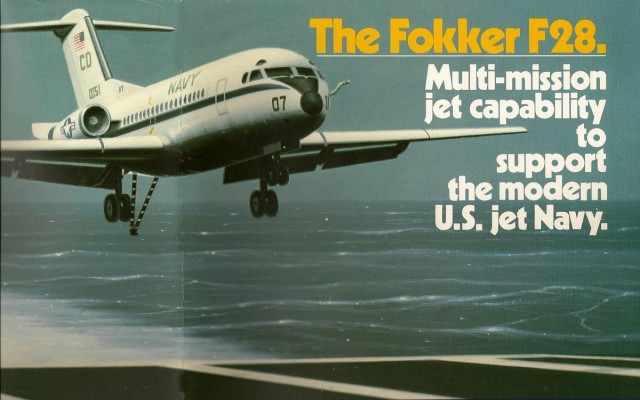
An artist’s representation of the F28 COD proposal landing on a carrier, from a Fokker sales brochure – Image: Fokker
With the Fokker MMVX proposal, a special STOL (Short Take Off and Landing) version of the F28 was penned. It featured redesigned landing gear that could extend to raise the nose of the aircraft, thus increasing the wing’s angle of attack to improve takeoff distance during a catapult launch, a tailhook, and a slightly redesigned wing that could fold for easier storage on the deck of the ship.
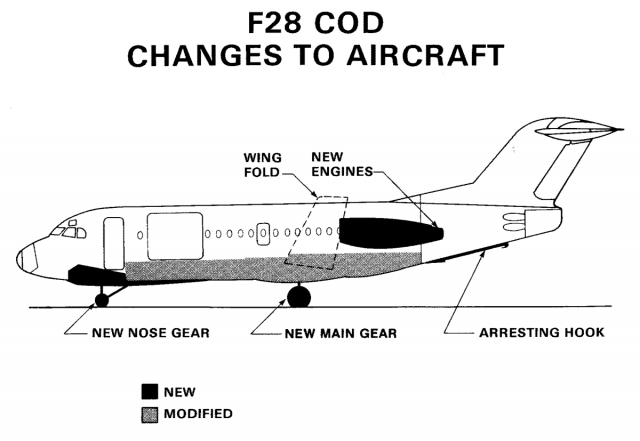
Another drawing from a Fokker sales brochure, highlighting the modifications to enable carrier operations – Image: Fokker
Instead of the standard Rolls Royce Spey turbofans that powered the standard F28, Fokker proposed to replace the engines with either Rolls Royce Tays from the F100, or a non-afterburning variant of the GE F404 turbofan that powered the F-18 Hornet.
Another feature that Fokker proposed was adding refueling pods to underwing hard points. This capability would allow the plane to refuel two fighters at once, doubling the previous carrier tanker’s capacity. Fokker went as far as demonstrating the performance of a stock F28 to the US Navy on a simulated carrier deck, but orders were not forth coming.
Next up was the McDonnell Douglas DC-9 COD proposal. As with the Fokker design, the DC-9 was proposed to feature redesigned landing gear, a slightly redesigned wing that could be folded, the addition of a tailhook, and improved avionics. Similar to the Fokker, the DC-9 COD could have also served as a tanker for the carrier fleet. The major focus of the redesign, however, was the nose landing gear.
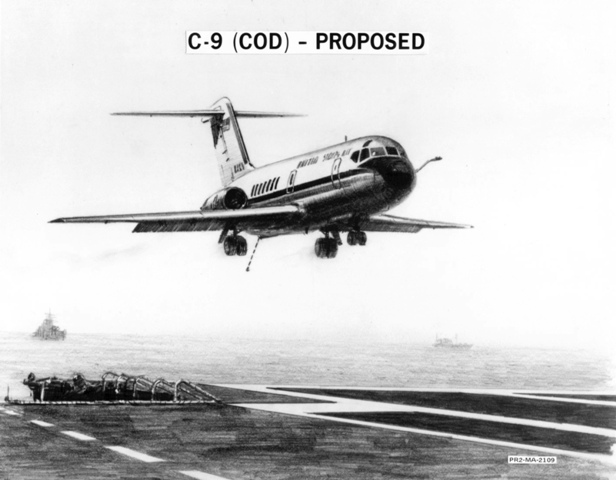
In this artist’s impression from the Douglas proposal to the US Navy, a DC-9 approaches a carrier deck – Image: Boeing
The Douglas engineers moved the nose landing gear aft roughly six feet, and also extended its length by two feet. This gave the aircraft a noticeable nose-up attitude on the ground, and served to increase the angle of attack of the wing for improved takeoff performance. However, with a pronounced nose-up angle, one has to wonder how easy it would have been to load and unload the aircraft through the large forward side cargo door.
Another feature that was common to both proposals was the addition of an air refueling probe that was mounted on the left side of the fuselage, similar to the probe that was featured on the Douglas A-4 Skyhawk.
Finally, there are two drawings of Boeing airliners that appear to be related to the MMVX competition, however, at this time, they have not been validated. They are noteworthy, though.
One of the drawings depicts a 727 in US Navy markings flying over a Forrestal-class aircraft carrier. The other conceptual drawing shows a 737-200 equipped with a tailhook landing on the deck of an aircraft carrier. At the time, it is unkown if these two drawings are truly representative of Boeing proposals for the MMVX program, but they are certainly amazing to look at!
As for what the designation of these aircraft would be – in the early 1980’s, both the DC-9 and the 737 were in active service with the US military, as the C-9 and T-43, respectively. So it is possible that the DC-9 would have been designated as the C-9D, and then since the next opening in the numbering sequence at the time was C-16 and C-17, it is possible the Fokker or Boeing proposals could have been assigned either.
In the end, the Navy decided to go a different route, and awarded Grumman a contract to produce 39 new-build C-2A Greyhounds. These aircraft soldier on to this day, and once again, the Navy is looking at replacing them. The current plan is to either modernize the C-2 yet again, or replace the current fleet with V-22 Ospreys. However, we are already seeing the making of a new competition in the same spirit as the MMVX program.
Lockheed has already proposed a dramatic reworking of the retired S-3 Viking aircraft, many of which are parked in the desert of Tucson. Dubbed the C-3, the aircraft would use the S-3’s wings and empennage while adding an all-new fuselage with a cargo capacity comparable to the C-2.
To sum up, the question begs to be asked: will we once again see a proposal to bring airliners to the deck of an aircraft carrier? In the mean time, the C-2 will continue to be a welcome site on carrier decks for years to come.
Comments are closed here.
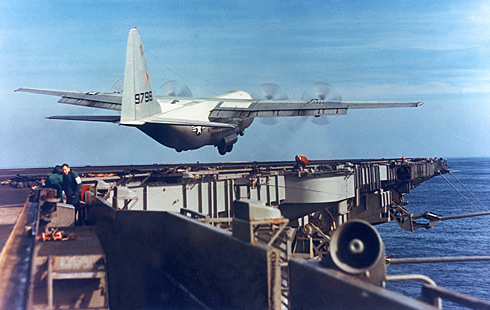
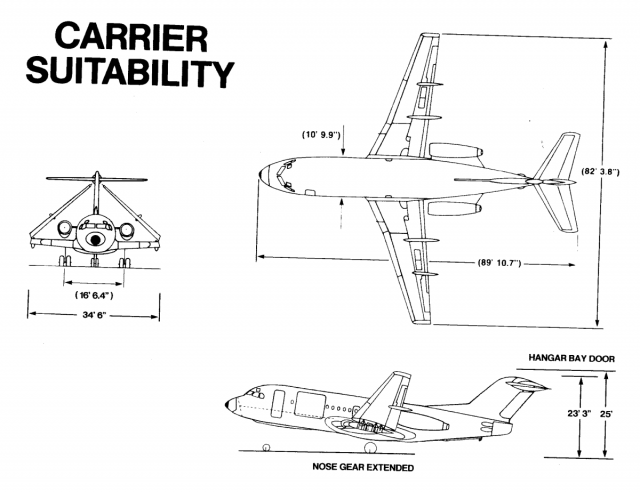
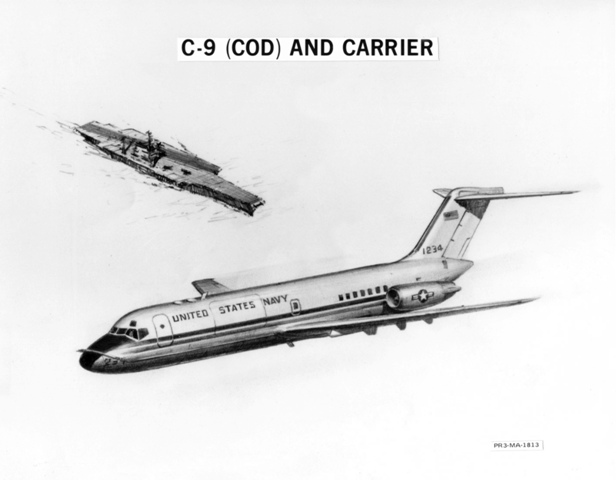
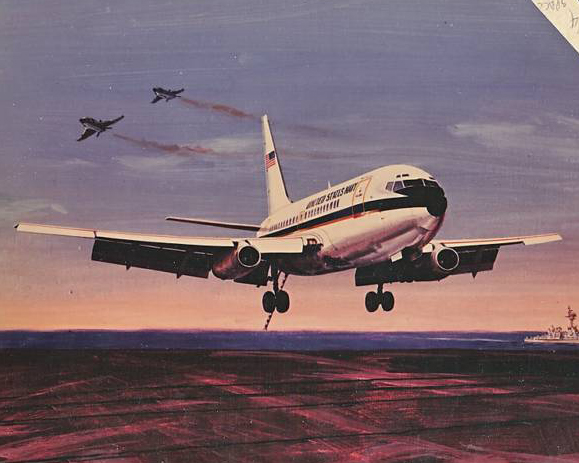
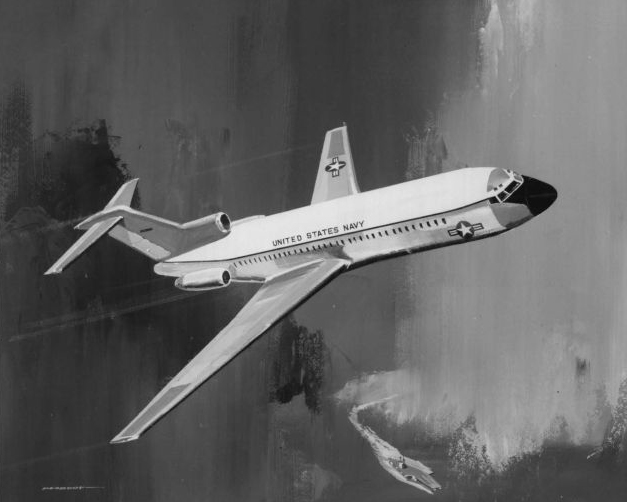
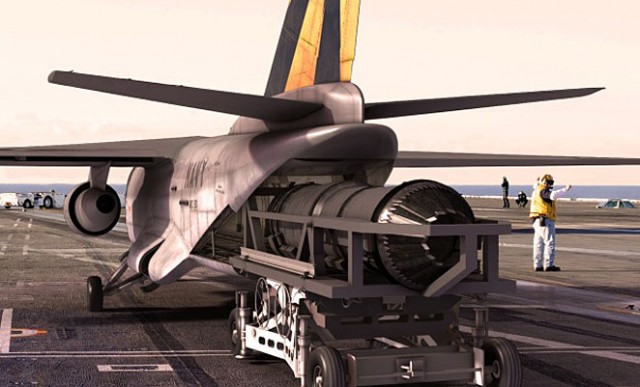
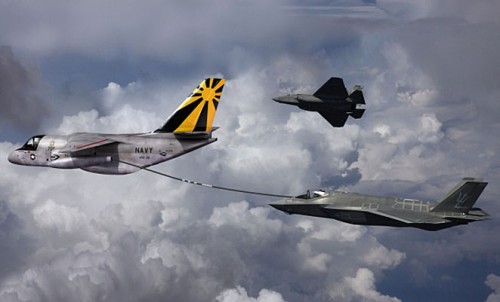
I don’t see how an arresting cable on an aircraft carrier could ever handle the weight of a 737?
If so, then why not base P-8As on aircraft carriers?
Also could these aircraft have the thrust to bolter and get back into the air?
Joe, one thing that you would have to remember is that the proposed 737 COD was based on a stripped down 737-200, so the MTOW, or Max Take Off Weight would have been less than 100K lb as mentioned below. I am sure that the engines would have been uprated versions of the JT8D as well. But, since not much is known about this proposal, it is hard to say.
Thanks much for explaining how this could even be possible.
Hi Kris,
My 1967 Janes All the World”s Aircraft has a mention in the 727 write-up regarding the use of the 727 as a possible COD. I would suggest the A/C sketch of the 727 over the Forrestal Class Carrier is from the mid sixties and most likely from the Boeing proposal.
Arresting cables were designed to handle 100,000 pound aircraft (as were the catapults). The first gen 737 was just barely over that at MTOW, so it would be easy to get it below for naval operation.
P-8a weighs almost 200,000 pounds at MTOW.
I love all of them! 🙂
… but can one imagine the nicknames the F-28 would have received from the sailors?
Sooooooooo,
What are the chances that we will see an A380N variant?
Just kidding
But wait, they aren’t going to develop a COD variant of the Hornet?
My Dad was involved in the testings of the 727 being used as a COD. I have seen the actual pictures of it on the deck of the aircraft carrier that it was tested on and no arresting cable or take off assist was used. Thrust reverses and advanced braking systems were used for landings.
Could you post any of the pictures?
Hello All – Sorry about coming late to the party.
My Father, Bruce Rayfield, was the Boeing engineer that came up with this concept. If you have an early edition of “Legend & Legacy: The Story of Boeing and Its People” by Robert J. Sterling you will find a small excerpt about the project. Just look up my father’s name in the index. It was “last one out of town..turn out the lights” era of Boeing in the 60’s and everyone was figuring out how to keep the company alive. My father thought a commercial derivative may have some opportunities in a military application.
They actually used a T-43 737 nav trainer that already had a tail hook to test the viability of an arrested landing. They successfully landed the T-43 on the carrier deck test runway at Whidbey Island Naval Air Station.
The calculation for weight to thrust ratio for the 737 with full flap indicated it would not need a catapult to get off the deck. This was proven later when the Navy did test land a 737 on a carrier deck as indicated by a Boeing historian 20 years ago. They used full thrust reversers to land (no tail hook) and full flap/throttle to take off (no catapult).
The Navy looked closely at the 737 COD proposal but found a flaw in the concept. They could fold up enough of the 737 wing to fit it on an aircraft carrier elevator but they could not fold enough of the tail to get it into the lower deck. The Navy was unwilling to tie up an elevator to offload/load a COD. This would have a high impact on the efficiency of the aircraft carrier during operations.
So…all that is left is the excerpt in the” Legend & Legacy” book and the concept painting (shown on this page), which I inherited from father when he passed in 1997.
Cheers!
Hey Lance, better late than never :). Thanks for sharing your connection with this story. A very nice thing to inherit from your father!
David | AirlineReporter